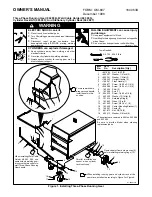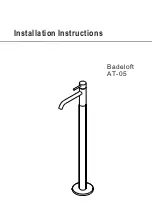
www.jbl.com
4
www.jbl.com
SPeaker Placement
PLaciNg tHe sOuNdBar ON a taBLe
If your TV is placed on a table, you can place the soundbar on the table
directly in front of the TV stand, centered with the TV screen. As long
as the surface of the table is flat, the soundbar will rest on its rubber
bumpers.
WaLL-MOuNtiNg tHe sOuNdBar
If your TV is attached to a wall, you can use the included wall-mount
brackets to mount the soundbar on the wall directly below the TV
screen.
Determine the location for the soundbar on the wall. Make sure that
1.
the top of the soundbar will not block your view of the TV screen
when it is mounted on the wall.
Mark the locations of the soundbar wall-mount bracket holes on the
2.
wall. The holes for the left and right brackets are spaced
30-5/16” (770mm) apart, and are designed to accept 4mm diameter
screws. The top and bottom holes for each bracket are spaced 1”
(25mm) apart. See the illustration below.
30-5/16" (770mm)
1" (25mm)
(not to scale)
30-5/16" (770mm)
1" (25mm)
(not to scale)
NOTE: To ensure that the soundbar will be level, use a carpenter’s level,
laser sight or other device to ensure that the two sets of holes are at
exactly the same height.
Attach the two wall-mount brackets to the wall at the locations
3.
you marked, using hardware that is appropriate for the wall’s
construction and materials. Note that the soundbar weighs 2.5kg
(5.5 lb). Be sure to use hardware that can support this weight.
After making all of the connections described in the
4.
Connections
section, on page 5, attach the soundbar to the brackets by sliding
the brackets’ vertical tabs into the slots in the soundbar’s rubber
bumpers.
Slide Bracket Tabs
into Slots in
Rubber Bumpers
Slide Bracket
Tabs into Slots in
Rubber Bumpers
PLaciNg tHe suBWOOFer
The performance of a subwoofer is directly related to its placement in
the listening room and its physical position relative to the other speakers
in the system.
While it is true that in general, our ears do not hear directional sounds
at the low frequencies where subwoofers operate, when installing
a subwoofer within the limited confines of a room, the reflections,
standing waves and absorptions generated within the room will strongly
influence the performance of any subwoofer system. As a result, the
specific location of the subwoofer in the room does become important
to the amount and quality of bass that is produced.
For example, placing the subwoofer next to a wall generally will increase
the amount of bass in the room; placing it in a corner (
1
) generally will
maximize amount of bass in the room. However, corner placement
can also increase the destructive effect of standing waves on bass
performance. This effect can vary depending on the listening position –
some listening positions may yield very good results, while others may
have far too much (or too little) bass at certain frequencies.
In many rooms, placing the subwoofer along the same plane as the
soundbar (
2
) can produce the best integration between the sound of the
subwoofer and that of the left and right speakers. In some rooms, the
best performance could even result from placing the subwoofer behind
the listening position (
3
).
1.
2.
3.
Soundbar
TV
We strongly recommend that you experiment with placement before
choosing a final location for your subwoofer. One way you can
determine the best location for the subwoofer is by temporarily placing
it in the listening position and playing music with strong bass content.
Move around to various locations in the room while the system is
playing (putting your ears where the subwoofer would be placed), and
listen until you find the location where the bass performance is best.
Place the subwoofer in that location.
IMPORTANT: The maximum wireless operating distance between the
soundbar and subwoofer is approximately 50 feet (15.3m).
0255CSK - JBL SB300_120-230V_QSG, WORK06.indd 4
19/11/10 13:56:23




























